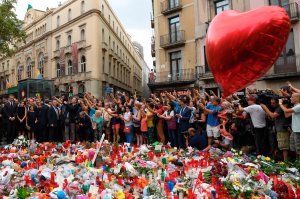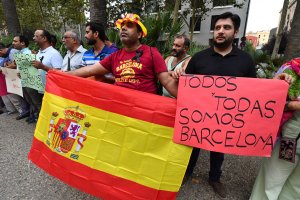An international manhunt was underway Saturday for the driver of a van that killed 13 people in Barcelona as police probed the wreckage of a suspected bomb factory for clues to the cell behind this week’s two terror attacks in Spain.
The flattened ruins of a house in the village of Alcanar have become the center of a massive police investigation into the terror cell suspected of using the house to make bombs.
When an explosion destroyed the house Wednesday night, killing one person and seriously injuring another, it set in train a series of events culminating in the deaths in Barcelona and one more in a second attack in the town of Cambrils.

A manhunt has been ongoing since a van plowed into pedestrians Thursday afternoon on Las Ramblas in the heart of Barcelona, killing 13 and injuring 120.
Early Friday, a group of five attackers wearing fake suicide belts drove into pedestrians in Cambrils, killing one and injuring six. Police shot all five assailants dead but said late Friday it was “increasingly unlikely” that the Barcelona driver was among them, Reuters reported.
A Catalan police spokesman on Saturday confirmed the names of three of the five suspects killed in Cambrils as Moussa Oukabir, Said Aallaa and Mohamed Hychami.
He also said that Younes Abouyaaqoub, who’s wanted in connection with the Barcelona attack, remains on the run. Spanish media report that Abouyaaqoub is a 22-year-old Moroccan national.
Authorities said the terror cell involved in the attacks — believed to number about 12 members — has been “completely dismantled,” Spanish Interior Minister Juan Ignacio Zoida said Saturday.
Five of the 12 lived in Ripoll, a city north of Barcelona. Three were arrested, one is unaccounted for, and another is one of the dead suspects, Oukabir. Another arrest was made in the village of Alcanar.
CNN reporters went to Oukabir’s apartment in Ripoll. A neighbor, Raimon Garcia, said Oukabir was one of four siblings — two brothers and two sisters.
Oukabir’s brother, Driss, was among those arrested. He turned himself into police when his identification was found in the Barcelona van, telling authorities he wasn’t involved in the attack.
A man who claimed to be a cousin of the brothers said Moussa Oukabir was “brainwashed.”
A woman who lives next to a mosque in the neighborhood told CNN that she had witnessed the Oukabir brothers attending the place of worship “every day for many years.”
Bulldozer clears rubble in Alcanar
The ruins of the house in Alcanar, a quiet beach town about 125 miles south of Barcelona, may hold the key to unraveling the plans and methods of the terror cell.
Police suspect the property was being used as a base to make explosives that could have caused even more devastating attacks in Barcelona, Cambrils and possibly elsewhere had they not blown up prematurely.
Explosives experts brought in a bulldozer Saturday to clear rubble before conducting a number of controlled explosions at the site in Alcanar’s Montecarlo area.

The city’s vice mayor, Jordi Bort, told CNN the house belonged to a bank and the group had been squatting there illegally without its knowledge.
The town is home to a mix of yearlong residents and others who just spend holidays or weekends here, he said. Neighbors said they did not suspect any wrongdoing at the property.
The septic tank of the house, which had only one floor, was used as storage for the tanks and explosives, Bort said.
Police said Friday there were other “biological remains” found at the site, but it is unclear whether they belong to someone other than the person confirmed dead there.
Source: Traces of TATP found
Wednesday’s explosion meant the attackers were unable to use material they were planning to deploy in the attacks, Catalan police Chief Josep Lluis Trapero said Friday.
The attack in Barcelona, capital of the Spanish region of Catalonia, was therefore “more rudimentary than they originally planned,” Trapero said.
Trapero said the suspects in Alcanar had been trying to “make explosives out of butane gas among other things.”
A source briefed on the investigation said a preliminary assessment indicated there were traces of the powerful explosive TATP in the rubble.
TATP is made by adding an acid to a mixture of acetone and hydrogen peroxide solution and can easily result in accidental detonation if mistakes occur in the preparation.
TATP was used in the November 2015 Paris attacks, the March 2016 Brussels bombings and the May bombing in Manchester, England.
Many of those who have successfully made TATP received some form of terrorist training.
ISIS issued a formal claim of responsibility for the two attacks Saturday. However, the extremist group did not provide any proof it carried out the attack or provide the names of the attackers or the number of them. There are also inconsistencies between ISIS’ statement and the police version of events.

Crowds show defiance, solidarity
In Barcelona, crowds returned Saturday to Las Ramblas, a popular tourist section, and street vendors were once again selling drinks and ice cream from kiosks on the Plaça de Catalunya, close to where Thursday’s attack began.
Residents and visitors paid tribute to the victims of the attack at makeshift memorials, where flowers, candles, toys and messages of support continue to pile up.
Catalan resident Marina Balius told CNN: “The people of Barcelona have united, they have no fear. The Catalans have an expression, ‘Your people are our people,’ and that has been demonstrated in the aftermath of the attack.”
King Felipe VI, the Spanish head of state, visited injured survivors of the attack in two hospitals Saturday.
Catalan authorities said 34 nationalities are among the victims in Barcelona, with an American, a Canadian and three Italians named so far among the dead.
Security measures are being enhanced in areas where large crowds gather, said Zoida, the interior minister, adding that there does not appear to be an immediate threat of another attack.
Spain’s threat level will remain at Level 4 following the terror attacks, one down from the maximum, Zoida said.















